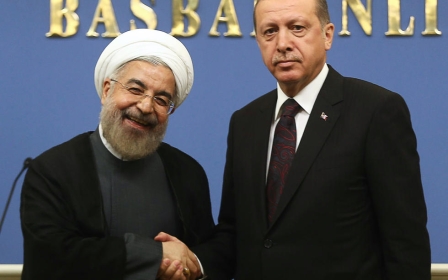Iran eyes opportunity in Turkey’s new anti-Kurdish drive

After more than four years of conflict, Turkey appears to be exploiting the Syrian civil war to gain maximum strategic advantage. Under the cover of a half-hearted anti-Islamic State (IS) drive Turkey hopes to create a buffer zone in northern Syria, in addition to imposing a no-fly zone.
Furthermore, Turkey aims at delivering a crushing blow to its old foe, the Kurdistan Workers Party (PKK), with a view to negotiating more favourable peace terms with the broader Kurdish movement.
Turkey’s bold and aggressive offensive in pursuit of two critical strategic objectives has not gone unnoticed in Tehran. Significant Turkish gains on either front are a challenge to Tehran’s regional strategic posture, thus necessitating a credible Iranian response.
Whilst in Syria Iran is likely to counter Turkish efforts by increasing support for the Syrian armed forces and allied militia, the challenge posed by Turkey’s latest anti-PKK drive requires a more subtle response.
Despite the fact that the Kurds are not natural allies of the Islamic Republic, Iranian strategists may consider integrating the PKK and its offshoots into Iran’s regional influence architecture, the so-called “resistance” front.
Similar to Turkey’s offensive, the Iranians are hoping to achieve two aims, to bolster Assad’s position in Syria, in addition to applying pressure on Massoud Barzani’s KDP-led administration in Iraqi Kurdistan.
But this is a move fraught with difficulties, not least because of the shifting alliances within regional Kurdish politics, and its intersection with the highly sensitive issue of Iran’s domestic Kurdish population.
Turkey’s offensive
Turkey’s direct intervention in the Syrian Civil War, under the guise of fighting IS, has been widely interpreted in Tehran as an excuse to apply intolerable pressure on Turkey’s real foe, the Bashar Assad administration in Damascus.
As a result Iranian media and social media activists have intensified attacks on Turkey, portraying Ankara as an ally of IS and other jihadists in Syria. While these claims may be exaggerated, there is little doubt over Turkey’s support for a wide range of Syrian rebels, including those with a strong Islamist bent.
While hitherto Turkey has limited its actions to airstrikes against alleged IS positions, and controversially against some Kurdish YPG units, the fear in Tehran is that the Turks want to go much further, by creating a buffer zone and potentially a countrywide no-fly zone across Syria.
The scope and intensity of Iran’s immediate response to these moves will be shaped by the quality of the information collected by Iranian intelligence. While it is doubtful Iranian spies are aware of the full extent of the Turkish-American agreement on Syria (which has facilitated the use of the Incirlik air base by the Americans), nonetheless they are probably sufficiently informed to effectively support Iranian counter-moves inside Syria.
A renewed offensive near the Lebanese border (spearheaded by Hezbollah), with a view to capturing the strategic town of Zabadani, as well as supporting the Syrian armed forces and allied militia to retrench on the fringes of the Alawite heartland, is part of a broader Iranian plan to reassure the Syrian regime and its supporters at a time of intensifying stress.
In view of Turkish moves against the YPG-ruled Kurdish enclave in the north, Iran may for the first time consider directly supplying the Syrian Kurds. Whilst the YPG maintains a tacit alliance with Damascus, and by extension with Hezbollah, hitherto the Syrian Kurds have not been directly supported by Tehran.
The Iranians will likely a drive a hard bargain in their negotiations with the Syrian Kurds. The YPG may have been an effective counter to IS but this of little significance to the Iranians who do not regard IS as a threat, at least not inside Syria.
A highly desirable scenario from an Iranian point of view would be the application of pressure by the YPG on the rebel alliance in and around Aleppo with a view to easing the intense pressure on government forces in that region.
But any Iranian deal with the YPG necessitates reaching a broader understanding with the PKK, which at minimum acts as the former’s ideological patron.
A Kurdish gamble
Dealing with the PKK is fraught with challenges and hazards. For a start the PKK also has an Iranian extension in the form of PEJAK (Party of Free Life of Kurdistan) which for over a decade has been shooting at Iranian forces inside and outside Iranian Kurdish regions. In response the Iranian government has detained and executed scores of PEJAK fighters and sympathisers.
Any contact with the PKK is also bound to infuriate Turkey which regards the latter as its deadliest security threat. While the Iranians are wary of the experience of the 1990s (when sections of the Turkish government and media routinely accused Iran of helping the PKK), those reservations may have been removed by Turkey’s increasingly strident role in Syria.
On the positive side, dealing with the PKK not only sends a strong message to Ankara, but it also fires a warning shot to Massoud Barzani’s fiefdom in Erbil. And it would be a move which is likely to be endorsed by a wider Kurdish audience, as evidenced by the rival PUK founder Adel Murad’s call on Iran to assume a greater role in Kurdish affairs.
In the final analysis, any Iranian overture to the PKK and its affiliates is likely to be marked by extreme caution and precision. While the latter can be integrated more deeply into the Syrian government’s battle against an assortment of rebel groups, they are not sufficiently trustworthy to assume a long-term position in Iran’s regional influence architecture.
- Mahan Abedin is an analyst of Iranian politics. He is the director of the research group Dysart Consulting.
The views expressed in this article belong to the author and do not necessarily reflect the editorial policy of Middle East Eye.
Photo: Syrians refugees in Turkey who had fled their home due to the civil war, return to the Syrian Kurdish town of Kobane on 10 August 2015 at Mursitpinar Border Gate in Sanliurfa, Turkey. (AA)
Middle East Eye propose une couverture et une analyse indépendantes et incomparables du Moyen-Orient, de l’Afrique du Nord et d’autres régions du monde. Pour en savoir plus sur la reprise de ce contenu et les frais qui s’appliquent, veuillez remplir ce formulaire [en anglais]. Pour en savoir plus sur MEE, cliquez ici [en anglais].





